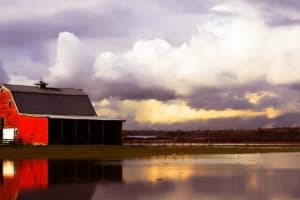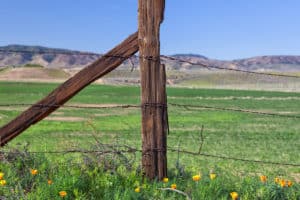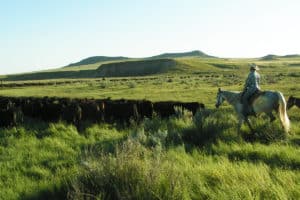We’ve been in the time of hay for more than a month. This is the hot center cut of summer, that slab of days when each breath breaks a sweat.
Farmers are making hay while the sun roasts. Heat makes misery in this work. The only worse misery is too much rain, which keeps farmers from making hay when it should be made or spoils cut hay before it can be baled.
In my part of Virginia’s mountains, our hay is typically a mix of cool-season perennials like orchardgrass, bluegrass and tall fescue; native warm-season grasses; and legumes (which fix nitrogen in the soil), such as clover. Thistles and burdock turn up at this prom like obnoxious thugs from a rival high school. Alfalfa, a planted legume, is rarely grown here, since it’s a five-star meal for three-star cattle.
While our hay is made over several months, the best is put up during a two-or-three-week sweet spot when the seeds are not quite mature but the leaves of grass are fully developed.
Cut too soon, and the hay’s moisture content will be too high. This impedes curing and causes other problems. Cut too late, and it’s less palatable and nutritious.
I’ve helped a neighbor make cattle hay as late as November, which we both knew would amount to nothing more than nutritiously empty belly filler. We made it…because it would not have felt quite right to leave it unmade.
Farmers make hay as soon as the window opens and go until they’ve put up the last bale, long after the window has closed and the shades have been drawn. Stockpiles are usually a mix of different hay quality—excellent, good, fair and poor.
Hay is stored solar energy. It feeds livestock during the months when pasture plants — even weeds — are dormant. Cattle and other ruminants with their four-chamber stomachs get the lower quality stuff. Horses need better chow because they have only one stomach. Behind their backs, horses are called, “hindgut fermenters,” as are elephants, pigs and wombats.
On short-summer mountain land like ours, one cut of hay is the norm. Farmers in wetter and warmer places can cut the same hayfield two to four times each season. A first cutting produces more bales per acre than successors, but the quality tends to be lower.
In a one-cutting place like Blue Grass, it makes little financial sense for a person who only needs a couple of hundred bales to devote the land and acquire the machinery to make it himself. It makes more sense to pony up the $3 or more per square bale for the quality that’s needed and have it delivered and stacked where it’s supposed to be.
But I know farmers with small hay needs who insist on making their own. They’re particular, and they want their hay just so.
Made-hay is taken as an expression of the maker’s character. Is it weedy? Was it put up damp? Is it tightly bound? Is it a good size? It takes skill and integrity to make good hay down to the last flake.
I’ve found that most farm jobs share two characteristics: First, they’re not much fun; and second, each one is finite. Every field contains only so many bales of hay; each fence line requires driving no more than a certain number of stakes. I find semi-self-delusional reasoning ever more useful as I get older.
Most farmers now make round bales, which are really chunky cylinders. They weigh from about 800 pounds to more than 2,000 depending on the equipment. When they’re wrapped in plastic, they remind me of giant, chopped-up Tootsie Rolls. One person properly equipped can cut, fluff, rake, bale and stack round bales from a tractor seat.
The older method made square bales, which are really rectangular prisms or rectangular parallelepipeds. Novice hay buyers should stick to haggling over the price of square bales and not insist on geometric correctness.
Once the grass is cut, fluffed up to dry with a tedder and raked into windrows, a tractor pulls a baling machine that spits out twine-wrapped square bales. Each weighs 50 to 100 pounds in the field. As they dry in the barn, they lose water weight.
Two or three people “make square bales”—one on the tractor, one or two on the wagon hitched to the baler. The job ends with stacking the bales in the barn. Square bales involve more sweat, more risk, more pain and more time; round bales involve more invested capital.
In light of the years I spent in undergraduate liberal arts and graduate school, I am always assigned to “work the wagon.” As each bale is pushed out of the baler and up its tail-like metal chute, I’m supposed to grab it with a metal hook, carry it to the back of the wagon and “build a load” of 100 to 120 bales from back to front. All of this hooking, carrying and building has to be done before the baler spits out the next parallelepiped. If I’m a slug and don’t get there in time, the rogue bale rolls off the wagon and down the sloped field like a convict running for freedom. Those with a chip on their shoulders come apart as they tumble.
While working the wagon is generally considered something that any 14-year-old farm kid knows how to do, it’s trickier than it appears. All the hooking, carrying and stack-building takes place on a rolling, pitching, lurching platform that is slicker than a peeled peach.
The bales have to be stacked tightly and interlocked or they will fall off the wagon. “Loose load” is not something that you want to find in your obituary. A tight load resists the wagon’s inevitable jostling that jiggles your stack into a mountain of Jell-O. It takes spatial sense and experience to build a load six or even seven courses high that survives turn after turn on a 30-degree slope.
If “your” load falls off, the tractor bunny takes a break, gets a drink of water, stretches and may compose a pertinent haiku to pass the time. When your load is on the ground, it’s your job to put it back on. Do this three or four times, and you will either learn how to build a load or figure a way to switch places with the tractor bunny.
At its best, working a wagon is hot, dusty, dangerous work. But it gets worse.
Once you’ve hauled the wagon to the barn, the hay has to be unloaded and restacked, which is hotter, dustier and just as dangerous.
In recognition of my extensive CEO experience and talent for telling underlings what to do, I was started right at the top of this organization—30 feet up in the hayloft, just under the metal roof. Outside, in the shade, it was 95 degrees.
To get bales to the top of the loft, they might have to be thrown upward, bale by blessed bale, in three or four lifts. A mechanical hay loader spares you only the first lift or two. Sooner or later, each square bale has to be barn-stacked individually by hand.
Making millions of square bales each summer left rural America with ruined backs and hostile teenagers. Round bales are better for big farms, but square bales will always be needed on places with just a few four-leggers.
Putting up hay is a farmer’s save-and-spend strategy. You save in the summer what you need to spend in the winter. And it’s always better to have a little left over than to run short.
This summer’s hay will be found in every drib of milk and cheese and every drab of beef and lamb that we eat in 2011. Like a few other things, it’s better that you don’t find any.
This content may not be used or reproduced in any manner whatsoever, in part or in whole, without written permission of LANDTHINK. Use of this content without permission is a violation of federal copyright law. The articles, posts, comments, opinions and information provided by LANDTHINK are for informational and research purposes only and DOES NOT substitute or coincide with the advice of an attorney, accountant, real estate broker or any other licensed real estate professional. LANDTHINK strongly advises visitors and readers to seek their own professional guidance and advice related to buying, investing in or selling real estate.









8-13-10
Very well written and most entertaining. Your article brought back fond memories of days gone by.
Your article is very entertaining; however, VERY dated for the western US. Being a hay farmer myself, it brings back memories. Out west we do not use round bales They are like hauling “tootsie rolls” down the road when you take them in to storage! We bali in the larger bales , but they are one ton bales (rectangles)4x4x6 or 3x4x6. And yes, that is feet measures! Everything is baled dry during the heat of the day so that it does not burn from internal combustion due to excess moisture. (Sure wish I had been able to work days instead of nights all those years.) And the stacking and loading are all mechanical also. Sure makes my back feel better than doing it by hand.
But this brings up another ponderance — Real Estate as a profession is much the same asfarmiing. You have the same hours, the same pay schedule, the same liabilities; just a heck of a lot less risk! We just changed our crop from hay to people! And I love every minute of it!